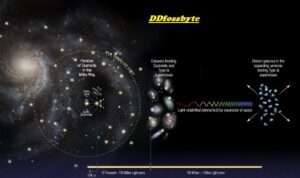Advancements in the field of cosmology have led to the development of a groundbreaking method aimed at significantly improving the accuracy of measuring cosmological distances. This innovative technique promises to revolutionize our understanding of the universe’s vast dimensions.

A groundbreaking exploration of cosmic realms has materialized through the intricate statistical analysis of a staggering one million galaxies. Collaborative efforts between researchers hailing from various Chinese universities and the University of Cordoba have culminated in a significant milestone—publication in the esteemed journal, Nature Astronomy. A labor of over two years, this monumental endeavor has unveiled a novel avenue for precisely determining cosmological distances, ushering forth a new era of precision.
Refining Cosmological Measurements
The new method is poised to refine our ability to measure distances between celestial objects with unprecedented accuracy. Cosmological distances, which play a pivotal role in deciphering the vastness of the cosmos, have long been a subject of exploration for astronomers and researchers alike. This cutting-edge technique holds the potential to provide more precise insights into the spatial arrangement of celestial bodies.
The Power of Gravitational Lensing
At the heart of this technique lies the phenomenon of gravitational lensing. This natural occurrence, predicted by Einstein’s theory of general relativity, involves the bending of light as it passes through massive objects. By carefully studying the gravitational lensing effects on distant galaxies, scientists can deduce the precise distances between these galaxies and Earth.

Unveiling the Cosmic Web
The accurate measurement of cosmological distances is crucial for understanding the intricate cosmic web that connects galaxies, galaxy clusters, and filaments of dark matter. This newfound ability to measure distances more precisely will contribute to unraveling the mysteries of the universe’s structure and evolution.
Collaborative Efforts and Technological Advances
This innovative method is the result of collaborative efforts by researchers and astronomers utilizing cutting-edge technology. The intricate analysis of gravitational lensing data, coupled with advanced computational models, has paved the way for this breakthrough technique.
Implications for Cosmology
The implications of this method extend far beyond distance measurements alone. Precise cosmological distance calculations are fundamental in determining key cosmological parameters, such as the Hubble constant, which characterizes the expansion rate of the universe. As accurate measurements of these parameters are refined, they contribute to a more comprehensive understanding of the universe’s age, evolution, and fundamental properties.
Future Prospects
As technology continues to advance and data collection methods become more sophisticated, the new technique holds great promise for future cosmological studies. It stands as a testament to human curiosity and our unwavering quest to explore the mysteries of the cosmos.

Concluding Thoughts
The introduction of this pioneering method for measuring cosmological distances marks a significant leap forward in our quest to comprehend the vast expanse of the universe. As the scientific community embraces this technique and refines its application, it brings us closer to unraveling the intricate tapestry of cosmic existence and expanding the boundaries of human knowledge.

Central to this study’s innovation is the introduction of an evolved approach to detecting Baryon Acoustic Oscillations (BAO), a phenomenon originating from the earliest epoch of the cosmos. Conceived in the crucible of the Big Bang’s aftermath, these oscillations emerged as resonant waves during the universe’s initial 380,000 years, akin to sound waves reverberating through a fluid-like, scorching matter. Subsequently, the cosmos underwent an expansion and cooling, causing these waves to become imprinted in temporal suspension, preserving a cosmic tapestry that holds a glimpse into the universe’s infancy.

Dr. Antonio J. Cuesta, an esteemed physicist affiliated with the University of Cordoba,
The Ingenious Methodology: Seeking Galactic Anomalies
Illuminating the Past and Expanding Cosmic Horizons

The study, which was published in the journal Physical Review Letters, analyzed a database of approximately one million galaxies. The researchers found that the galaxies were more likely to be elongated in the direction of the gravitational pull of other galaxies. However, there were certain places in the universe where this effect was not as pronounced.
The new method is still under development, but it has the potential to revolutionize the way we measure cosmological distances. More accurate distance measurements will allow scientists to better understand the expansion of the universe and the evolution of galaxies.

The transformational implications of this Baryon Acoustic Oscillations-based approach reverberate across the expanse of astronomy. By refining cosmological distances, a tapestry woven of answers to the universe’s enigmatic facets, including its composition in terms of enigmatic components such as dark matter and energy, comes into clearer focus. The cosmos, ever a realm of captivating mysteries, unveils a new chapter through this unparalleled revelation.
